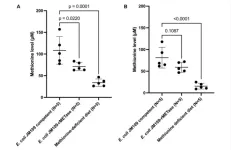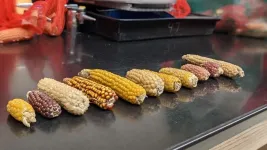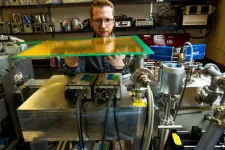(Press-News.org) DURHAM, N.C. – What people say they’ve eaten and what they’ve actually eaten are often two very different lists of foods. But a new technique using DNA barcoding to identify the plant matter in human feces may get at the truth, improving clinical trials, nutrition studies and more.
Building on earlier studies that attempted to compare DNA found in feces with reported diets, researchers in the lab of Lawrence David, an associate professor of molecular genetics and microbiology in the Duke School of Medicine, have developed a genetic marker for plant-based foods that can be retrieved from poop.
“We can go back after the fact and detect what foods were eaten,” said Brianna Petrone, PhD, an MD/PhD student who led the project.
The marker is a region of DNA plants use to power chloroplasts, the organelle that converts sunlight into sugars. Every plant has this genomic region, called trnL-P6, but it varies slightly from species to species. In a series of experiments, they tested the marker on more than 1,000 fecal samples from 324 study participants across five different studies, about twenty of whom had high-quality records of their diet.
In findings appearing June 27 in the Proceedings of the National Academy of Sciences, the researchers show that these DNA markers can indicate not only what was consumed, but the relative amounts of certain food species, and that the diversity of plant DNA found in feces varies according to a person’s diet, age, and household income.
David’s lab relied on a reference database of dietary plants that contains markers for 468 species typically eaten by Americans to connect versions of trnL-P6 detected in poop to specific plant sources. After some tweaking, their barcode was able to distinguish 83 percent of all major crop families.
Petrone said the subset of crop families that could not currently be detected tended to be consumed in other parts of the world. The lab is now working to add crops such as pearl millet and pili nuts to their database.
They also haven’t tracked meat intake yet, though the technology is capable of that as well, David said. “That relative ratio of plant to animal intake is probably one of the most important nutritional factors we might look at.”
The scientists first tried the marker out on fecal samples from four individuals in a weight loss intervention where they knew exactly what study participants had been fed a day or two before. Knowing the patients had been given a dish called mushroom wild rice pilaf for example, they looked for the markers of its components: wild rice, white rice, portobello mushrooms, onion, pecans, thyme, parsley and sage.
In this and a second intervention group, they found that barcoding could not only identify the plants, it also could identify relative amounts consumed for some kinds of plants. “When big portions of grains or berries were recorded in the meal, we also saw more trnL from those plants in stool,” Petrone said.
Then they looked at samples from 60 adults who had taken part in two studies of fiber supplementation and kept track of what they were eating with surveys. The number of plants detected by trnL was in good agreement with dietary diversity and quality estimated from participants’ survey responses.
Next, they applied the barcoding to a study 246 adolescents with and without obesity with diverse racial, ethnic, and socioeconomic backgrounds. There was only a minimal record of diet in this cohort.
“Dietary data collection was challenging because some traditional surveys are 140 pages long and take up to an hour to fill out, families are busy, and a child might not be able to fill it out alone,” David said. “But because they had banked stool, we were able reanalyze those samples and then gather information about diet that could be used to better understand health and lifestyle patterns between kids. What really struck me was that we could recapitulate things that were known as well get new insights that might not have been as obvious.”
They found 111 different markers from 46 plant families and 72 species in the adolescents’ diet. Four kinds of plants were eaten by more than two thirds of subjects: wheat, found in 96 percent of participants, chocolate (88%), corn (87%) and the potato family (71%), a group of closely related plants that includes potato and tomatillo.
David said the barcode isn’t able to distinguish individual members of the cabbage family – the brassica – such as broccoli, Brussels sprouts, kale, and cauliflower, which are closely related.
Still, the large adolescent cohort showed that dietary variety was greater for the higher-income study participants. The older the adolescents were however, the lower their intake of fruits, vegetables and whole grain foods, potentially because of a known pattern of older children eating with their families less often.
David said the barcode is readily able to identify the diversity of plants found in a sample as a proxy for dietary diversity, a known marker of nutrient adequacy and better heart health.
David said that in each of these cohorts, the genomic analyses had been carried out on samples that had been collected years in the past, so the technique opens up the possibility of reconstructing dietary data for studies that have already been finished.
The authors think the new methodology should be a boon for all sorts of studies of human nutrition. “We are limited in how we can track our diets, or participate in nutrition research or improve our own health, because of the current techniques by which diet is tracked,” David said. “Now we can use genomics to help gather data on what people eat around the world, regardless of differences in age, literacy, culture, or health status.”
The team anticipates extending the technique to studies of disease across the globe, as well as monitoring food biodiversity in settings facing climate instability or ecological distress.
Funding for this work came from the National Institute of Diabetes and Digestive and Kidney Diseases (grants 5R24DK110492-05 and 5R01DK116187-05), the Burroughs Wellcome Fund Pathogenesis of Infectious Disease Award, the Duke Microbiome Center, the Springer Nature Limited Global Grant for Gut Health, the Chan Zuckerberg Initiative, the Triangle Center for Evolutionary Medicine, the Integrative Bioinformatics for Investigating and Engineering Microbiomes Graduate Student Fellowship, and the Ruth L. Kirschstein National Research Service Award to the Duke Medical Scientist Training Program. This work used a high-performance computing facility partially supported by grants from the North Carolina Biotechnology Center (2016-IDG-1013 and 2020-IIG-2109).
CITATION: “Diversity of Plant DNA in Stool is Linked to Dietary Quality, Age and Household Income,” Brianna L. Petrone, Ammara Aqeel, Sharon Jiang, Heather K. Durand, Eric P. Dallow, Jessica R. McCann, Holly K. Dressman, Zhengzheng Hu, Christine B. Tenekjian, William S. Yancy, Jr., Pao-Hwa Lin, Julia J. Scialla, Patrick C. Seed, John F. Rawls, Sarah C. Armstrong, June Stevens, Lawrence A. David. PNAS, June 27, 2023.
DOI: 10.1073/pnas.2304441120
Online: https://www.pnas.org/cgi/doi/10.1073/pnas.2304441120
END
DNA barcoding identifies the plants a person has eaten
Reliable technique should improve clinical trials, nutrition studies and historical research
2023-06-27
ELSE PRESS RELEASES FROM THIS DATE:
Methionine restriction reverses old-age obesity in mice
2023-06-27
“This is the first report that showed the efficacy of methionine restriction to reverse old-age-induced obesity.”
BUFFALO, NY- June 27, 2023 – A new research paper was published in Aging (listed by MEDLINE/PubMed as "Aging (Albany NY)" and "Aging-US" by Web of Science) Volume 15, Issue 11, entitled, “Old-age-induced obesity reversed by a methionine-deficient diet or oral administration of recombinant methioninase-producing Escherichia coli in C57BL/6 mice.”
Obesity increases with aging. Methionine restriction ...
The 2023 Ogawa-Yamanaka Stem Cell Prize awarded to Magdalena Zernicka-Goetz
2023-06-27
SAN FRANCISCO, CA—Magdalena Zernicka-Goetz, PhD, was announced today as the recipient of the 2023 Ogawa-Yamanaka Stem Cell Prize by Gladstone Institutes. Zernicka-Goetz is a professor of mammalian development and stem cell biology in the Department of Physiology, Development, and Neuroscience at the University of Cambridge, as well as the Bren Professor of Biology and Biological Engineering at the California Institute of Technology.
A pioneering stem cell scientist, Zernicka-Goetz was selected for the prize because of her work uncovering fundamental mechanisms that drive the development of mammalian embryos, which led to the ...
Unsafe feeding methods spiked during infant formula shortage
2023-06-27
Nearly half of parents who relied on formula to feed their babies during the infant formula shortage last year resorted to potentially harmful feeding methods, according to a survey from researchers at the University of California, Davis. The study was published in the journal BMC Pediatrics.
In an online anonymous survey of U.S. parents, the number of individuals that used at least one unsafe feeding practice increased from 8% before the formula shortage to nearly 50% during the shortage. Unsafe practices included watering down formula, using expired or homemade formula, or using human milk from informal sharing.
The percentage of parents who shared human milk ...
Illinois study reveals genetic secrets of America's favorite snack
2023-06-27
URBANA, Ill. – In its simplest form, popcorn is pretty uncomplicated. Most supermarket varieties offer the choice of two kernel colors, yellow or white, and two kernel shapes, pointed or pearl. When popped, the flake typically expands into one of two shapes: mushroom or butterfly. But there’s more to popcorn than meets the eye. New research from the University of Illinois Urbana-Champaign reveals a wealth of untapped diversity lurking in popcorn’s genetic code.
Analyzing 320 publicly available popcorn lines, crop sciences researchers found variation at more ...
UC Irvine scientists develop freely available risk model for hurricanes, tropical cyclones
2023-06-27
Irvine, Calif., June 27, 2023 — As human-driven climate change amplifies natural disasters, hurricanes and typhoons stand to increase in intensity. Until now, there existed very few freely available computer models designed to estimate the economic costs of such events, but a team of researchers led by Jane W. Baldwin at the University of California, Irvine recently announced the completion of an open-source model that stands to help countries with high tropical cyclone risks better calculate just how much those storms will impact their people and their economies.
“Tropical cyclones are some of the most impactful natural disasters on Earth. They pose huge risks ...
New model provides unprecedented window into human embryonic development
2023-06-27
Two to three weeks after conception, an embryo faces a critical point in its development. In the stage known as gastrulation, the transformation of embryonic cells into specialized cells begins. This initiates an explosion of cellular diversity in which the embryonic cells later become the precursors of future blood, tissue, muscle, and more types of cells, and the primitive body axes start to form. Studying this process in the human-specific context has posed significant challenges to biologists, but new research offers an unprecedented window into this point in time in ...
Deaf mice can have virtually normal auditory circuitry: implications for cochlear implants
2023-06-27
Researchers at Johns Hopkins University, US, led by Calvin Kersbergen report that mice with the most common form of human congenital deafness develop normal auditory circuitry – until the ear canal opens and hearing begins. Publishing June 27th in the open access journal PLOS Biology, the study suggests that this is possible because spontaneous activity of support cells in the inner ear remains present during the first weeks of life.
Mutations to the protein connexin 26 are the most common cause of hearing loss at birth, accounting for more than 25% of genetic hearing loss worldwide. To understand how these mutations lead to deafness ...
Deaf mice have nearly normal inner ear function until ear canal opens
2023-06-27
**EMBARGOED TILL TUESDAY, JUNE 27, AT 2 P.M. ET**
For the first two weeks of life, mice with a hereditary form of deafness have nearly normal neural activity in the auditory system, according to a new study by Johns Hopkins Medicine scientists. Their previous studies indicate that this early auditory activity — before the onset of hearing — provides a kind of training to prepare the brain to process sound when hearing begins.
The findings are published June 27 in PLOS Biology.
Mutations in Gjb2 cause more than a quarter of all hereditary forms of hearing loss at birth in people, according to some estimates. The connexin 26 protein coded by ...
Chemists are on the hunt for the other 99 percent
2023-06-27
The universe is awash in billions of possible chemicals. But even with a bevy of high-tech instruments, scientists have determined the chemical structures of just a small fraction of those compounds, maybe 1 percent.
Scientists at the Department of Energy’s Pacific Northwest National Laboratory (PNNL) are taking aim at the other 99 percent, creating new ways to learn more about a vast sea of unknown compounds. There may be cures for disease, new approaches for tackling climate change, or new chemical or biological threats lurking in the chemical universe.
The work is part of an initiative known as m/q or “m over q”—shorthand ...
Easier access to opioid painkillers may reduce opioid-related deaths
2023-06-27
Increasing access to prescription opioid painkillers may reduce opioid overdose deaths in the United States, according to a Rutgers study.
“When access to prescription opioids is heavily restricted, people will seek out opioids that are unregulated,” said Grant Victor, an assistant professor in the Rutgers School of Social Work and lead author of the study published in the Journal of Substance Use and Addiction Treatment. “The opposite may also be true; our findings suggest that restoring easier access to opioid pain medications may protect against fatal overdoses.”
America’s opioid crisis has ...
LAST 30 PRESS RELEASES:
Why nail-biting, procrastination and other self-sabotaging behaviors are rooted in survival instincts
Regional variations in mechanical properties of porcine leptomeninges
Artificial empathy in therapy and healthcare: advancements in interpersonal interaction technologies
Why some brains switch gears more efficiently than others
UVA’s Jundong Li wins ICDM’S 2025 Tao Li Award for data mining, machine learning
UVA’s low-power, high-performance computer power player Mircea Stan earns National Academy of Inventors fellowship
Not playing by the rules: USU researcher explores filamentous algae dynamics in rivers
Do our body clocks influence our risk of dementia?
Anthropologists offer new evidence of bipedalism in long-debated fossil discovery
Safer receipt paper from wood
Dosage-sensitive genes suggest no whole-genome duplications in ancestral angiosperm
First ancient human herpesvirus genomes document their deep history with humans
Why Some Bacteria Survive Antibiotics and How to Stop Them - New study reveals that bacteria can survive antibiotic treatment through two fundamentally different “shutdown modes”
UCLA study links scar healing to dangerous placenta condition
CHANGE-seq-BE finds off-target changes in the genome from base editors
The Journal of Nuclear Medicine Ahead-of-Print Tip Sheet: January 2, 2026
Delayed or absent first dose of measles, mumps, and rubella vaccination
Trends in US preterm birth rates by household income and race and ethnicity
Study identifies potential biomarker linked to progression and brain inflammation in multiple sclerosis
Many mothers in Norway do not show up for postnatal check-ups
Researchers want to find out why quick clay is so unstable
Superradiant spins show teamwork at the quantum scale
Cleveland Clinic Research links tumor bacteria to immunotherapy resistance in head and neck cancer
First Editorial of 2026: Resisting AI slop
Joint ground- and space-based observations reveal Saturn-mass rogue planet
Inheritable genetic variant offers protection against blood cancer risk and progression
Pigs settled Pacific islands alongside early human voyagers
A Coral reef’s daily pulse reshapes microbes in surrounding waters
EAST Tokamak experiments exceed plasma density limit, offering new approach to fusion ignition
Groundbreaking discovery reveals Africa’s oldest cremation pyre and complex ritual practices
[Press-News.org] DNA barcoding identifies the plants a person has eatenReliable technique should improve clinical trials, nutrition studies and historical research






